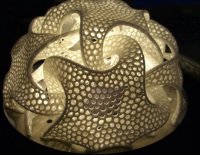Computers and Fabrication: Revolutionizing the Art World
It may come as a surprise that one of the four teaching certifications I hold is K-12 Art Education. It is a certification that I am excited to finally use in my new position in the fall. Throughout high school, I took private art lessons with a local artist. I learned how to mix paint colors, complete paintings with a limited palette, paint with a palette knife, and create drypoint etchings, linoleum prints, mixed media and clay sculpture, as well as how to work in a variety of drawing techniques. For each project we worked on, we also received a lesson in art history, giving us context for the technique or materials we were using.
Old School Technology
As I reflect on my experiences, I realize that all of these creating and making experiences involved a variety of technologies. Often, when we use the word "technology," we assume that it must refer to a technological computing device. However, as I often tell my students, there was a time when a simple pencil was a game-changing technology. While printmaking, I used a drypoint needle to scratch into plastic. To make our prints, we had to ink up plates and run them through a press. While these are not new technologies, they are not-so-distant cousins of new technologies we see today.
Many of these older technologies are still in use in digital fabrication labs (FabLabs) and MakerSpaces around the world. Artists and "Makers" in these communities use the old tools in conjunction with newer ones to create works of art and everyday objects. Imagine an artist creating a piece for his art installation on a sewing machine and stitching in conductive thread so he can incorporate LEDs into the piece. Or imagine a sculptor who creates with clay and incorporates objects created with a 3D printer into the piece.
What's Art? Who's an Artist?
There is a lot of discussion about whether digital art can be considered "fine art" and what kind of impact digital art will have, ultimately, in the art world. I would equate the impact of digital art with any art movement that forced people to rethink what they considered art in the first place. (I'm channeling my inner Duchamp, Warhol and Pollock here.) Artists have been incorporating multimedia into their pieces for decades, but computers have created a new evolution of the simple video montage or sound and light enhancements. We are now forced to consider as "artists" the computer programmer who creates a program that incorporates input from individuals' smartphones or manipulates the lights on a building to allow for the world's largest game of Pong. For those who would say this is blasphemy, I ask you to visit the Philadelphia Museum of Art to view Marcel Duchamp's "Fountain" (hint: it's a urinal) or Michelangelo's fresco on the ceiling of the Sistine Chapel (a larger-than-life public art piece).
For those who fear that we, as humans, will stop making art with our hands, one only has to look at the many FabLabs and MakerSpaces (there are even MakerFaires!) around the country and in our schools to see that hands-on creativity is not dying -- it's simply evolving. Young people are still attending art schools, still painting, sculpting and printing, many of them in "traditional" ways.
Picking Up STEAM
So what is the implication for K-12 schools? First and foremost, we need to fund the arts in our schools. We also need consider that some of the artists in our schools and communities may be programmers or makers, not just illustrators and painters. Our art programs should reflect the art that our young people see every day and the tools that they are accustomed to using. As much as I am not a fan of trendy, buzzword acronyms, I would argue that the new trend toward incorporating STEAM (Science, Technology, Engineering, Art and Math) can start the process of rethinking what we consider art and acknowledging the evolving world of digital art and Maker communities.
